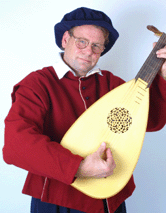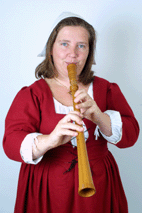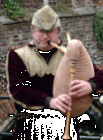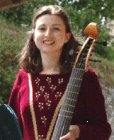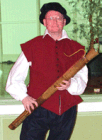A Tudor Christmas by Minstrels Gallery
A seasonal saunter through the Golden Age of Tudor Music. Christmas with the Tudors was a time of elaborate pageants, masques, miracle plays, tournaments, banquets and dancing, and it was the duty of the ‘Master of the Revels’ to oversee these entertainments. Buy this album now CD: £9.99 + p&p |
| 1 | Veni, Veni Emanuel | French Plain Song 15C |
| 2 | Miri It Is | Anon English 13C |
| 3 | Stella Splendens | Llibre Vermell Spain 14C |
| 4 | Gaudete | Jistebnice Cantianal 1420 |
| 5 | Green Groweth The Holly | Henry VIII |
| 6 | The King’s Pavanne | Ravenscroft 1582-1635 |
| 7 | Maravillosos | Cantigas de Santa Maria 13C |
| 8 | Coventry Carol | Anon English 1591 |
| 9 | Consort XIV | Henry VIII |
| 10 | Ah Robin, Gentle Robin | William Cornysh |
| 11 | Three Toyes Sellingers Round, Buffons & Robin Reddocke |
Anon |
| 12 | Pastime With Good Company | Henry VIII |
| 13 | Greensleeves To A Ground | John Johnson |
| 14 | The Boar's Head Carol | Anon |
| 15 | En Vray Amoure | Henry VIII |
| 16 | Helas Madame | Henry VIII |
| 17 | Tourdion | Adrian Le Roy |
| 18 | Sussex Carol | Anon English |
| 19 | Riu, Riu, Chiu | Anon Spanish 16C |
| 20 | Shepherds Dance | Susato 1551 |
| 21 | Blow Thy Horn Hunter | William Comysh |
| 22 | Paduane Au loly Bois | Morlaye |
| 23 | If I Had Wit For To Endite | Anon |
| 24 | Belle Qui Tiens Ma Vie | Thoinot Arbeau |
| 25 | Blame Not My Lute | Anon |
| 26 | Dance | Anon |
| 27 | Tomorrow The Fox | Thomas Ravenscroft |
| 28 | The Waits | Anon English |
| 29 | Villanesque | Morlaye |
| 30 | Bacco Pipes Jig | Anon English |
| 31 | Of All the Birds | Thomas Ravenscroft |
| 32 | Bear Dance | Anon English |
| 33 | Blessed Be That Maid Marie | Anon 15C |
Sleeve Notes Christmas with the Tudors was a time of elaborate pageants, masques, miracle plays, tournaments, banquets and dancing, and it was the duty of the ‘Master of the Revels’ to oversee these entertainments. A man who had been in the employ of Henry VII took on this responsibility at the court of Henry VIII: he was William Cornish. Cornish was a musician and master of the Chapel Royal, and it was the children of the chapel royal who provided Henry with one of his favourite entertainments: the seasonal mystery play, a combination of spectacle, drama, music and dance. Gifts were exchanged, not on Christmas Day, but on New Years Day and the celebrations continued, culminating on the 6th of January: Twelfth Night. Christmas was a time to turn the normal year on its head. One of the more unusual Christmas traditions was the appointment of a boy bishop. A boy from the choir would be chosen to conduct all the duties of a bishop except celebrating mass. Communities all over the country appointed a boy bishop, usually on Twelfth Night, and in London he would lead a large procession through the streets. Another Christmas institution was the Lard of Misrule whose job it was to supervise entertainments and generally instigate chaos. At Canterbury the character was known as ‘Prester John whilst in Norwich it was the King of Christmas’ who paraded through the streets. One practice that was particularly popular at the universities and Inns of Court was the quite barbaric Boxing Day practice of letting a fox and cat loose in the Inner Temple hall and set a pack of hounds upon them. Though the great feasting was reserved for Twelfth Night, Christmas Day was hardly a time of denial. Dining would begin with the arrival of the boards head, accompanied by the singing of the ‘Boards Head’ carol published by the wonderfully named Wynkyn de Worde. This course would have been followed by roast swan, pheasant, pork and many other meat dishes, before the final course of rare sweetmeats. It is this course that was known as the ‘banquet’ as sugar was a very expensive commodity in the late Middle Ages. Our traditional Christmas turkey can in fact be traced back to Henry’s time, having been introduced into England in around 1523. Bred in Norfolk, the hapless fowl was walked in large flocks down to London to feature in the Christmas celebrations. Today the lorries of Bernard Matthews can be seen tracing the same route! For the majority of Henry’s subjects, still very much a peasant class, Christmas would come as a welcome break from the drudgery of daily life. Most non-essential work would halt over the Christmas period including one of the prime occupations for women: spinning. Flowers were ceremonially placed around the spinning wheel to prevent its use, though I doubt that this met with much resistance. The peasantry did of course, not enjoy the rich and plentiful fare available to the royal court. One thing they could look forward to was the mince pie. The pie would have included thirteen ingredients representing Christ and his apostles; dried fruits, spices and a little chopped mutton in remembrance of the shepherds. Music and entertainment was very traditional, with mummers plays being performed on the village green or street, and one of the primary sources of music for dancing was the bag pipes. Work would resume on Plough Monday when the tradition was to drag a plough around the village gathering money. It was then left in the church as a communal implement for any villagers to use on their smallholding. Christmas day 1558 was an important day for England, as the country was about to be ruled by a new queen. On Christmas day Princess Elizabeth made her religious position clear by removing herself from the mass in the Chapel Royal. With her religious allegiance undisputed she was crowned Queen Elizabeth 1st on 15th January 1559. Though perhaps not quite as extravagant as her father, the new Queen was not sparing when it came to entertainment and celebration. She too enjoyed music and dancing and played well on the lute and virginals (a harpsichord-like instrument). The giving of Christmas gifts, always on New Years Day, was carefully recorded in the gift roll, hence we learn that in 1 558 when the court was at Greenwich for the seasons celebrations, two minor court servants each gave the queen a box of lute strings; a very practical gift as strings were then expensive, made of gut and very prone to breaking. Many of the Christmas customs of early Tudor times were still around during Elizabeth’s reign. A strange Twelfth Night tradition was to bake a rich fruit cake in which was hidden a dried pea. The lucky person that ate the cake and found the pea would become Queen of the Pea for a day, irrespective of gender! Alcohol has always played a large part in the Christmas ritual and spiced ale would have been served up in a large bowl accompanied by roast apples. This was then taken door to door by youths who demanded money. It was considered unlucky not contribute: a foolproof system! This tradition is closely allied to that of wassailing, a word derived from Anglo-Saxon meaning ‘good health”. The Wassailers often replaced ale with cider but essentially the idea was to collect money with a bowl and a shout of “wassail” to welcome in the New Year. The Tudor dynasty came to an end in 1603 with the death of Elizabeth. The flamboyance of the court of Henry VIII with its lavish entertainments was over. Today our Christmas celebrations owe more to the Victorians than they do the Tudors and by Boxing Day it’s all over. The twelve days of Christmas have been condensed into a single day the 25th of December. |
Credits Minstrels
Gallery Are:
|
| Instruments: | Tudor Instruments |
| Genre: | Tudor Music |
| Format: | CD Rom |
| Our Ref: | A0184 |
| MCPS: | MG000 |
| Label: | BEACON |
| Year: | 2006 |
| Origin: | UK |
Minstrels Gallery are a group specialising in music from medieval, through the Elizabethan period to the time of Oliver Cromwell. Between us we play over 40 different, accurately reconstructed instruments of the period. We also sing, recite verse and perform various other entertainments in keeping with past times. Minstrels Gallery; Martin, Tony and Jane, usually work as a trio but may be booked as a duo and for larger functions the group may be augmented up to seven players. We also work with a number of very good entertainers, juggler, stilt walker, fire eater, jester, and can also recommend falconers, jousters, knights on horseback, fight re-enactment groups, archers, hog roast and more.
Minstrels Gallery came about as a result of Tony's earlier experiences playing at medieval banquets in the Suffolk town of Bungay. Way back in late 1975 Tony was part of a group called 'Quodling's Delight' playing mainly at medieval banquets and the occasional concert. After
a gap of many years Tony formed a new group with his wife Jane
calling itself Minstrels Gallery. The membership of the group
has varied over the years but has now settled to a core of Tony,
Jane and son Martin. Other players join the group from time to
time either to meet the requirements of two engagements on the
same day or where a larger ensemble is needed.
|
||||||||||||||||||||||||||||
Contact
Details |
Tony
Scheuregger Minstrels Gallery 43 Muriel Road Norwich, Norfolk England NR2 3NY |
|||||||||||||||||||||||||||
Telephone |
01603 454402 | |||||||||||||||||||||||||||
Mobile |
07798 521577 | |||||||||||||||||||||||||||
E-mail |
info@minstrelsgallery.com | |||||||||||||||||||||||||||
Artists
Web Site |
www.minstrelsgallery.com | |||||||||||||||||||||||||||

